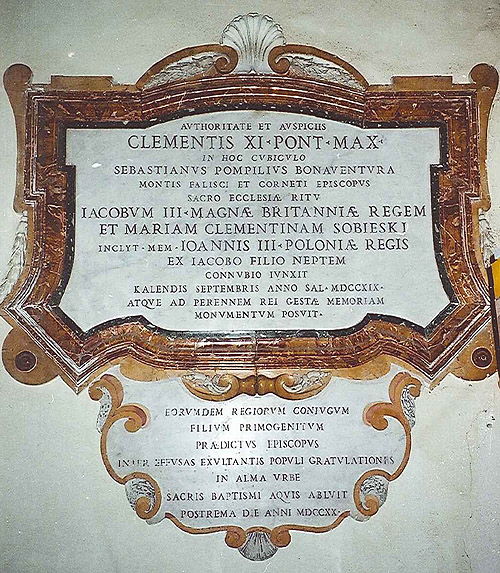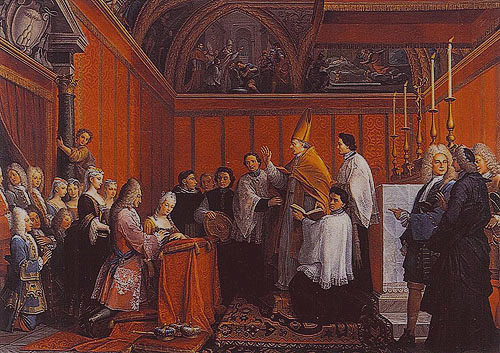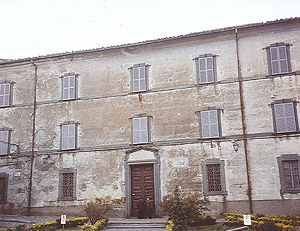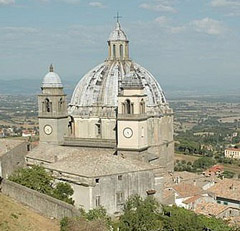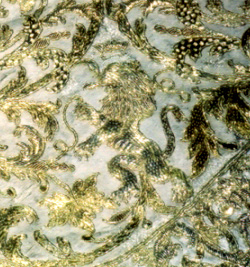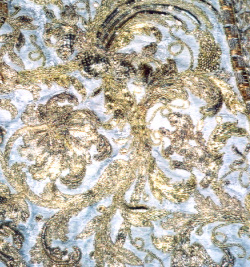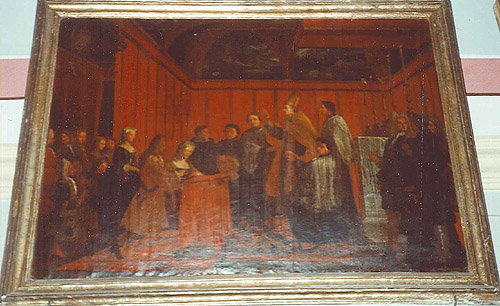 |
 |
 |
 |
 |
 |
 |
 |
 |
|
A Jacobite Gazetteer - Lazio
Montefiascone
A number of vestments can still be seen in the sacristy of the cathedral. At the far end of the sacristy is a chest of drawers below a painting of Saint Margaret (to whom the cathedral is dedicated). On the second drawer from the top is a label, "Parato in quarto della Regina Clementina d'Inghilterra".6 The white silk vestments are embroidered with thread of gold in designs of English roses and lions rampant. The chalice veil is embroidered with the scene of the baptism of Christ surrounded by tiny pearls. There is also an altar frontal embroidered with the royal arms which is still used today on the feast of Saint Margaret.
Several letters from James and Clementina to the cathedral canons about these gifts are in the cathedral archives. "In affectionate return for these gifts, the dignitaries of the cathedral promised to found an annual mass to be sung for England on St. Edward's Day".7 Above the doorway of the sacristy is a slightly different version of the painting of James and Clementina's wedding from that in the Scottish National Portrait Gallery. One source ascribes this version to Sebastiano Conca.8 In the Montefiascone painting there are four fewer figures in the background than in the Scottish National Portrait Gallery painting.9 The Montefiascone version is in a somewhat poor condition.
Notes 1 Helen Smailes, The Concise Catalogue of the Scottish National Portrait Gallery (Edinburgh: Trustees of the National Galleries of Scotland, 1990), 328, attributes the painting to Agostino Masucci (1691-1758) and dates it to about 1735. This painting is the same as that attributed to Carlo Maratti, displayed at the Stuart Exhibition in 1889, and formerly in the collection of the Earl of Northesk. Since Maratti died in 1713, he could hardly paint an event which took place in 1719. The editor of Exhibition of the Royal House of Stuart (London: New Gallery, 1889), 52, says that "this picture and the companion work [depicting the baptism of Charles III] . . . were painted for the Prince [i.e. James III and VIII] and presented by him to the Bishop of Montefiasconi [sic], though they appear to have been for a time in the palace of the Cardinal York. They remained in possession of the prelate's family, hanging in the Grand Saloon of the old Bonaventura Palace at Urbino. Gradually this ancient family died out, and, finally, when Olimpia and Ottavia, co-heiresses and last of the race, divided the remaining property, nearly all their art-possesssions were sold. The pictures were bought in 1845 by the eighth Earl of Northesk and brought to Scotland". It appears that the painting was purchased by the Earls of Rosebery some time before 1967, when it is placed in their collection by Bryan Bevan, King James the Third of England: A Study of Kingship in Exile (London: Robert Hale, 1967), 7. In 1977 the painting was acquired by the Scottish National Portrait Gallery. In 2005 the Scottish National Portrait Gallery also acquired a pen and ink sketch of the painting. 2 Alice Shield and Andrew Lang, The King over the Water (London: Longmans, Green, 1907), 343. Martin Haile, James Francis Edward, the Old Chevalier (London: J.M. Dent, 1907), 277. 3 Charles Wogan, Narratives of the Detention, Liberation and Marriage of Maria Clementina Stuart, Styled Queen of Great Britain and Ireland, edited by John T. Gilbert (Dublin, Ireland: John Dollard, 1894), 104. According to one source "Cardinal Gualterio had prepared the house of one of his relations for their [wedding] reception" (Haile, 277); presumably Bishop Bonaventura was a relative of Cardinal Gualterio. 4 Shield and Lang, 339-340. There is no trace of this today (2002); it is likely that the arms were merely a temporary display. 5 Shield and Lang, 385. Peggy Miller, James (New York: St. Martin's Press, 1971), 255, says that James "gave to the cathedral, as a mark of his gratitude, episcopal vestments, insignia and an altar frontal embroidered in gold; and Clementina gave a chasuble adorned with priceless oriental pearls which had formed part of her Sobieski dowry." 6 A "parato in quarto" is the set of vestments used at high mass (a chasuble for the celebrating priest, a dalmatic for the deacon, a tunicle for the sub-deacon, and a cope for the assisting priest). 7 Shield and Lang, 385-386. 8 Wayland Kennet and Elizabeth Young, Northern Lazio: An Unknown Italy (London: John Murray, 1990). Sebastiano Conca was born in 1680 and died in 1764; he worked in Rome, and completed a number of commissions for the House of Savoy. 9 Missing from the Montefiascone version are the young boy climbing the column, a woman immediately below him, another woman immediately to the left of James, and a cleric to the right of Father John Brown. Image 1 (Inscriptions): © Noel S. McFerran 2002. Image 2 (Wedding of James and Clementina, Scottish National Portrait Gallery): Edward Corp, The King over the Water: Portraits of the Stuarts in Exile after 1689 (Edinburgh: Scottish National Portrait Gallery, 2001), 73. Image 3 (Palazzo Episcopale, Montefiascone): © Noel S. McFerran 2002. Image 4 (Cathedral, Montefiascone): http://www.travelpod.com/travel-blog-entries/yulie/11/1254305490/tpod.html Image 5 (Vestment embroidery: crowned lion rampant): © Noel S. McFerran 2002. Image 6 (Vestment embroidery: rose and lion rampant): © Noel S. McFerran 2002. Image 7 (Wedding of James and Clementina, Cathedral of Montefiascone): © Noel S. McFerran 2002.
This page is maintained by Noel S. McFerran (noel.mcferran@rogers.com) and was last updated March 27, 2012. |
